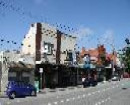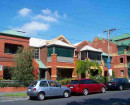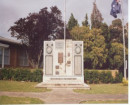RAILWAY PIER/STATION PIER
STATION PIER PORT MELBOURNE, PORT PHILLIP CITY
-
Add to tour
You must log in to do that.
-
Share
-
Shortlist place
You must log in to do that.
- Download report





Statement of Significance
This record has minimal details. Please look to the right-hand-side bar for any further details about this record.
-
-
RAILWAY PIER/STATION PIER - History
Railway Pier:
In 1852, the Government Pier (Town Pier) was still found to be insufficient for to service the demand created by the gold rush, leading to the construction of Railway Pier and the Melbourne and Hobsons Bay Railway Company, which linked Melbourne (at the Yarra swing basin) with Sandridge. Five sunken vessels used to support the new pier's piles, which was 800 ft long when it opened in 1852. The railway service which commenced in 1854 connected the deep water port to Melbourne. It was the first steam powered railway in the country and ran daily trips to the Hobson's Bay Sea Baths in 1852. A regular ferry service from Sandridge to Williamstown connected to rail services in 1854. The Pier, which was 800 ft long when first built, was subsequently extended in 1856 (by 550 ft), and again in 1857 (250 ft), 1858 (225 ft), and finally again to its final length of 2171 ft in 1861, when a curved outer section was added. The railway line's success was tied to the Bay Steamer Trade from 1872-1942.
The pier and railway were placed under the Victorian Railways Department in 1878, when the railway was renamed the Port Melbourne Railway Line. The ferry service from Sandridge to Williamstown connected to rail services, but was suspended by 1930.Station Pier:
Station Pier was constructed over the period from 1922-1930 over the previous site of Railway Pier. The winged berths and a rail link to the suburban railway were added from 1923-1924, and these facilities were extensively used for the Bay Excursion Steamers. Cargo handling was mechanised when semi portal cranes were installed in 1925, and road, rail and pedestrian access routes were improved. The first pier section when completed was 1460 ft long and had a small electricity substation to power the cranes and lights in 1926. Extensions began again that year with 750 ft added to its length. The passenger rail link was extended from Port Melbourne station to the Pier in 1927, but was discontinued again in 1930. The Bay Steamers presented a huge trade from 1925-1940. Passenger terminals were added on the pier, along with shelter sheds and kiosks in 1928. The controversial customs facilities, gatehouse and fence were added in period of industrial unrest from1928 -1930, and pier was completed in 1930. Centenary Bridge which enabled access over the railway line was opened in 1934, and the Boat Train service that connected Station Pier to Flinders St Station was running by 1936. Further improvements included electric cranes installed in 1937.
The pier experienced increased traffic associated with wartime activities from 1941, and in 1942 the US Navy purchased the last Bay Steamer (Weeroona). By this time the pier's wing sections were used for small vessel berthing and by anglers and mussel collectors. Station Pier was used extensively during the period of assisted immigration passages from 1947 - 1980, and was the first Australian port of call for many immigrants. The Federal immigration intake was reduced from 1972 to 1975, and 1978 saw the last immigrant ship call at Melbourne. Two portal cranes were installed 1948, and a luffing crane in1956. The railway platform was removed for parking by 1972, and the inner E berth was reconstructed and terminals refurbished for Tassie Ferry in 1984. The outer eastern and western berths were used for cruise ships and visiting naval vessels by 1992.
This site is included on the Heritage Register, and a more extensive history of this site is included in the Heritage Registration File.
RAILWAY PIER/STATION PIER - Interpretation of Site
The site extends approximately 700 m from the foreshore. Archaeological deposits are not expected to be found surrounding the pier where large vessels still use the pier (unless they have sunk into the substrate), but may still be in situ around the old Wing Piers (up to 25m out from the pier). However, archaeological deposits are expected to exist under the extended parts of the pier where limited or no dredging has occurred.
The potential for archaeological investigations into the construction and deposits surrounding the pier is high. The five vessels sunk to aid the stabilisation of the pier piles, represent some of the earliest hulks in existence in Victoria. Archaeological deposits associated with the use of the pier, are expected to be dense, especially under the extended part of the pier where less disturbance to the site has occurred.
Extensive dredging operations have been conducted around the pier to accommodate increasingly larger vessels over time, but archaeological discard may be evident on the outer edge of the adjacent channels, possibly up to 50 m from the pier. Given the prolonged use of this site over time it is highly probable that extensive archaeological deposits exist under the jetty itself with its various phases of construction. Lee (1993) maintains that extensive soil farming to decontaminate the site would have removed most archaeological sites between Princes and Station Piers, but Taylor's reports of archaeological material recovered during seawall construction in the mid 1990s contradict this (see H7822-0472).
Heritage Inventory Description
RAILWAY PIER/STATION PIER - Heritage Inventory Description
The site extends from the foreshore.
Deliberately abandoned vessels and archaeological deposits associated with pier use. Piles and other structural remains of the earlier stages of the Station Pier development, and from the earlier Railway Pier
Archeological Potential:
Excellent
-
-
-
-
-
PORT MELBOURNE COURT HOUSE, POLICE STATION AND LOCK-UP
 Victorian Heritage Register H1318
Victorian Heritage Register H1318 -
FORMER SWALLOW & ARIELL BISCUIT FACTORY
 Victorian Heritage Register H0567
Victorian Heritage Register H0567 -
JUBILEE TERRACE
 Victorian Heritage Register H1829
Victorian Heritage Register H1829
-
-









